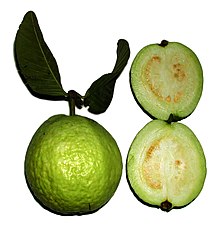Farang

Farang (in Thai : ฝรั่ง , pronounced: [ faràŋ ], in colloquial language often also falang ) is the common term in Thailand for foreigners with white skin, i.e. H. Europeans as well as Americans, Australians, South Africans, etc.
use
Basically, Farang is a neutral word, but it is only used in everyday language. In official contexts, however, it is avoided and replaced by the high-level expression Khon Tang Chat ( คน ต่าง ชาติ ) or Chao Tang Chat ( ชาว ต่าง ชาติ , "foreigner"). Depending on the context, Farang can also be understood derogatory or as a swear word. In particular, Farang Khi Nok ( ฝรั่งขี้นก ) describes an indecent Westerner (actually a type of guava whose kernels are believed to be spread via bird droppings). Europeans and Americans living and traveling in Thailand often use the term Farang as a self-designation.
African American US soldiers were also referred to as Farang Dam ("black Farang") during the Vietnam War ; however, it is more common to refer to Africans or African-Americans as Negro . South and West Asian foreigners (e.g. Arabs, Persians, Indians, Nepalese) are not called Farang , but Khaek ( แขก , literally: "Guests").
Children with one Farang and one Thai parent are called Luk Khrueng ( ลูกครึ่ง , literally translated as "half-child"). Related to the term Farang is the term Nok ( นอก , literally: “outside”), especially in the form of Mueang Nok ( เมืองนอก , literally “outside country” or “outside country”) for (western) foreign countries or the western world, Khong Nok ( ของ นอก , "foreign things") for mostly high-priced western products and Hua Nok ( หัวนอก , "outside head") for people who are influenced by western thinking, for example because they have studied abroad.
origin
The word farang probably comes from the Persian word farang ( فرنگ), as the Persians were trading partners of the Siamese (Thai) even before the Europeans. In Hindi in India the European is called farangi or Arabic alfrandsch , in Egypt and North Africa afrangui , in Ethiopia faranji ; in Thailand's neighboring country Cambodia barang and in Laos falang . The Persian traders who settled in Siam from the 16th century probably called all European Christians " Franks " (farang) . The Thai took over this name and referred it to the Portuguese, English and Dutch who later arrived in their country.
The word probably came from the early medieval Franconian empire and its successors in eastern and western France during the time of the crusades in the Middle East . Most of the participants in the first crusade were French and German (from the former West and East Franconia), so "Franke" became the general term for Christian Europeans in the Middle Ages. From there the term spread via the old trade routes to Asia and Africa, possibly even to Polynesia, where white Europeans are called "Palangi".
The popular etymology is that Farang derives from "français", since the French were among the first Europeans to settle in Southeast Asia. However, this is not plausible from either a historical or a linguistic point of view. The French are now referred to as Khon Farangset ( คน ฝรั่งเศส ) in Thai , but this word is of more recent origin than Farang .
Further meaning
Derived from this, farang has the general meaning “foreign”, “western” or “non-Thai”. In particular, Farang refers to the guava , which, originally native to South America, was made famous in Thailand by Portuguese traders. Further examples are Man Farang ( มันฝรั่ง ) for potatoes (from Man , มัน , ' Yams '), No Mai Farang ( หน่อไม้ฝรั่ง ) for asparagus (from No Mai , หน่อไม้ , ' bamboo shoots ') or Mak Farang ( หมากฝรั่ง ) for chewing gum (from Mak , หมาก , ' betel nut ').
media
The magazine Der Farang , founded in 1993, is the best-known German-language newspaper with the highest circulation in Thailand and is published every 14 days. The associated news portal is Der-farang.com . Its founder is Martin Rüegsegger. The Southeast Asia magazine Farang has been published in Berlin since 1997 . It is aimed at the Thai-German community, i.e. H. Thais living in Germany, Germans interested in Thailand and, above all, binational families. Both publications cooperate with each other.
See also
Web links
- The FAQ (Frequently Asked Questions) of the discussion group soc.culture.thai. Direct link to the article by linguist Gwyn Williams on the above website
- Variations of the Thai word farang in other languages (English)
- The Farang news portal from Pattaya
- Farang - Website of the Southeast Asia magazine from Berlin
literature
- Pattana Kitiarsa: An Ambiguous Intimacy. Farang as Siamese Occidentalism. In: Rachel V. Harrison, Peter A. Jackson: The Ambiguous Allure of the West. Traces of the Colonial in Thailand. Hong Kong University Press, Hong Kong 2010, pp. 57-74.
Individual evidence
- ↑ a b c Pattana Kitiarsa: An Ambiguous Intimacy. Farang as Siamese Occidentalism. 2010, p. 61.
- ↑ Pattana Kitiarsa: An Ambiguous intimacy. Farang as Siamese Occidentalism. 2010, pp. 71-73.
- ↑ Pattana Kitiarsa: An Ambiguous intimacy. Farang as Siamese Occidentalism. 2010, p. 68.
- ^ A b Muhammad Ismail Marcinkowski : From Isfahan to Ayutthaya. Contacts between Iran and Siam in the 17th century. Pustaka Nasional, Singapore 2005, ISBN 9971-77-491-7 , p. 5.
- ^ A b Jimmy Harris: The Persian connection: Four loanwords in Siamese. In: Pasaa. Volume XVI, No. 1 (June 1986), ISSN 0125-2488 , pp. 9-12.
- ^ Gwyn Williams: Origin of the Word “Farang”. Department of Linguistics, Thammasat University, March 26, 1994.
